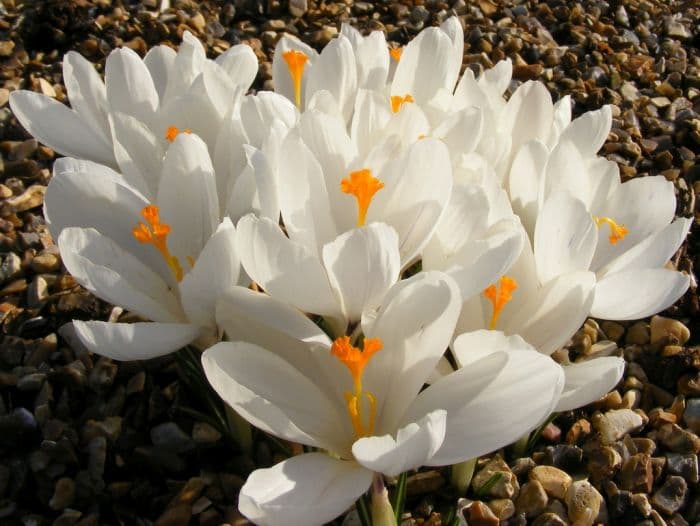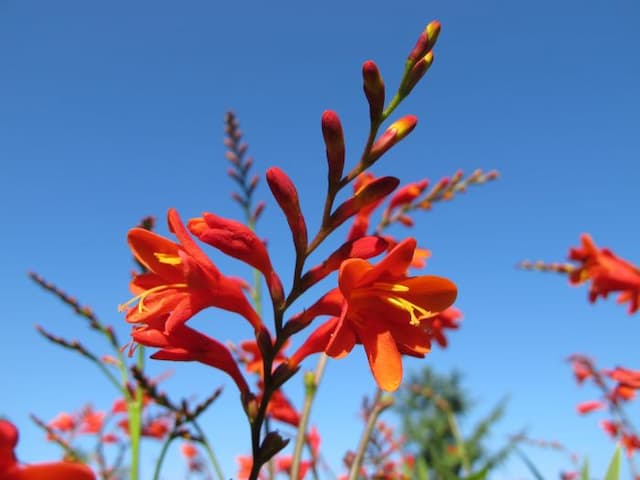Crocus Jeanne d'Arc Crocus 'Jeanne d'Arc'

ABOUT
The Crocus 'Jeanne d'Arc' is a striking flowering plant featuring a bold color palette that makes it stand out in early spring gardens. The flowers of this plant are large and cup-shaped, characterized by their pristine white petals that gleam in the sunlight. Adding to their allure, each petal's base is delicately marked with a radiant purple or mauve color, which beautifully frames the flower's vibrant golden-yellow stamens situated in the center. The flowers emerge on singular, slender stems that push through the last remnants of winter, signaling the arrival of warmer days. The contrast of the dark markings against the snow-white petals gives these blooms a regal appearance, fitting for a plant named in honor of French history's heroic Jeanne d'Arc. The foliage of the Crocus 'Jeanne d'Arc' is equally refined, consisting of slim, grass-like leaves that are often striped or tinged with a silvery-grey hue. These leaves tend to hug the ground, setting a verdant stage for the remarkable flowers above. As the plant matures, the foliage thickens, creating a lush undergrowth that accentuates the floral display. When planted en masse, Crocus 'Jeanne d'Arc' creates an impressive sweep of brightness that is a clear herald of spring. The plant tends to naturalize over time, which means it will gracefully spread and create larger clusters for a more impactful display in subsequent seasons. Despite its delicate looks, this crocus is known for its hardiness and durability, often one of the first splashes of color to break through the cooling temperatures. It's a beloved choice for gardeners looking to add early seasonal charm to their landscapes.
About this plant
 Names
NamesSynonyms
Jeanne d'Arc Crocus, White Crocus, Jeanne d'Arc Flower.
Common names
Crocus 'Jeanne d'Arc'.
 Toxicity
ToxicityTo humans
The Crocus 'Jeanne d'Arc', also known simply as the Crocus, is generally considered to have low toxicity for humans. However, if ingested, it may cause mild stomach upset. It is essential to handle this plant with care as it might contain compounds that can cause adverse effects when consumed.
To pets
The Crocus 'Jeanne d'Arc', or Crocus, can be toxic to pets, especially dogs and cats. The plant contains compounds that can lead to gastrointestinal upset if ingested, with symptoms such as vomiting and diarrhea. More severe symptoms can occur if large quantities are consumed, but such instances are rare. It is advisable to keep this plant out of reach of pets to avoid any potential poisoning.
 Characteristics
CharacteristicsLife cycle
Perennials
Foliage type
Deciduous
Color of leaves
Green
Flower color
White
Height
4-6 inches (10-15 cm)
Spread
2-3 inches (5-8 cm)
Plant type
Bulb
Hardiness zones
3-8
Native area
Mediterranean
Benefits
 General Benefits
General Benefits- Early Spring Bloom: Crocus 'Jeanne d'Arc' is one of the first flowers to bloom in the spring, bringing early color to the garden when most other plants are still dormant.
- Attracts Pollinators: The flowers provide an early nectar source for bees and other beneficial insects emerging in the spring.
- Low Maintenance: Once established, crocuses require minimal care, making them ideal for busy gardeners or those looking for low-maintenance landscapes.
- Naturalizing: Crocus 'Jeanne d'Arc' has the ability to self-seed and spread over time, creating a more extensive display each year without additional planting.
- Drought Tolerant: After blooming, these plants are relatively drought tolerant, as they go dormant in the summer months.
- Cold Hardy: As a bulb adapted to cold winter temperatures, Crocus 'Jeanne d'Arc' can survive harsh conditions and re-emerge in the spring.
- Container Gardening: Suitable for pots and containers, crocuses can be easily grown on patios, balconies, or other confined spaces.
- Landscape Versatility: These plants fit well in various landscape designs, from rock gardens to borders or as a lawn replacement for a spring meadow effect.
 Medical Properties
Medical PropertiesThis plant is not used for medical purposes.
 Air-purifying Qualities
Air-purifying QualitiesThis plant is not specifically known for air purifying qualities.
 Other Uses
Other Uses- Affixing botanical specimens: The petals of Crocus 'Jeanne d'Arc' can be used for adhering plant specimens onto herbarium sheets due to their paper-like quality.
- Saffron substitute: Although not a true saffron-producing crocus, the brightly colored stigmas could theoretically be used as a poor substitute in culinary settings for a less intense flavor and color.
- Photography projects: The striking white petals and contrasting yellow center provide a compelling subject for macro photography and plant studies.
- Natural dye: The pigments extracted from the flowers can be used to create a natural dye for textiles or art projects, albeit not as strong as traditional dye plants.
- Educational tool: Crocus 'Jeanne d'Arc' can be used in educational settings to teach students about plant biology and the life cycle of bulbous plants.
- Artistic inspiration: Artists may use the plant as inspiration for paintings, sketches, and other forms of art due to its distinct appearance.
- Seasonal celebrations: The flowers could be incorporated into springtime festivals and decorations, symbolizing purity and renewal.
- Floral arrangements: Although not common, Crocus 'Jeanne d'Arc' can be used in small floral arrangements or boutonnieres for special occasions.
- Crafting potpourri: Dried petals can be mixed with other herbs and spices to create a fragrant potpourri.
- Event markers: Strategically planting these crocuses in gardens to mark the arrival of spring or as a reminder of specific annual events.
Interesting Facts
 Feng Shui
Feng ShuiThe Crocus is not used in Feng Shui practice.
 Zodiac Sign Compitability
Zodiac Sign CompitabilityThe Crocus is not used in astrology practice.
 Plant Symbolism
Plant Symbolism- Hope: The Crocus 'Jeanne d’Arc', commonly known as the Crocus, often blooms in late winter to early spring, pushing up through the snow and symbolizing hope and the triumph of life over adversity, mirroring the story of its namesake, Joan of Arc.
- Purity: Its pristine white flowers are widely associated with purity and innocence, reflecting its clean and bright appearance.
- Youthful Gladness: Crocuses are symbolic of cheerfulness and the joy associated with youth, likely due to their early spring appearance, symbolizing the mirth of new beginnings.
- Rebirth: Crocus 'Jeanne d’Arc', flowering when the landscape is often still barren, symbolizes rebirth and a reminder that nature is once again awakening from its winter slumber.
 Water
WaterJeanne d'Arc Crocus, commonly known as Crocus, should be watered deeply and thoroughly to encourage the roots to grow deeply, providing more stability and access to nutrients for the plants. During the active growing period in the fall and early spring, water the crocuses once a week if there is no rainfall, providing about 1 inch of water which roughly translates to about 0.6 gallons per square yard. Reduce watering after the blooming period as Crocus generally enjoys drier conditions in summer dormancy. It’s important to ensure that the soil is well-drained to prevent the corms from rotting. Overhead watering should be avoided to prevent disease; instead, water at the base of the plant.
 Light
LightJeanne d'Arc Crocus thrives best in full sun to partial shade conditions. These plants prefer to be positioned in an area where they can receive at least 6 to 8 hours of direct sunlight a day. However, they can tolerate light shade, especially in the hotter parts of the day, which can help protect their delicate blooms from the intense midday sun.
 Temperature
TemperatureThe Jeanne d'Arc Crocus is best suited to the temperature conditions that replicate its native habitat. This crocus prefers colder climates with temperatures ranging from 35 to 65 degrees Fahrenheit for optimal growth. They can survive winter temperatures down to about -20 degrees Fahrenheit but typically need a period of winter chill to trigger spring flowering.
 Pruning
PruningPruning is not typically required for Jeanne d'Arc Crocus as they are low-maintenance plants. However, after flowering, it is beneficial to remove the spent flower heads to divert energy back to the corm for the next season's growth. Do not prune or cut back the foliage until it has died back naturally, as the leaves photosynthesize and generate energy that is stored in the corm for the next year.
 Cleaning
CleaningNot needed
 Soil
SoilThe Crocus 'Jeanne d'Arc', commonly known as the Jeanne d'Arc crocus, thrives in well-draining, moderately fertile soil. A mix of equal parts of potting soil, sand, and loamy garden soil with some added organic matter is ideal. It prefers a soil pH ranging from neutral to slightly alkaline, around 6.0 to 7.5.
 Repotting
RepottingThe Jeanne d'Arc crocus typically does not require frequent repotting. These corms should be repotted or divided every 3 to 5 years to avoid overcrowding and to maintain vigorous growth.
 Humidity & Misting
Humidity & MistingCrocus 'Jeanne d'Arc' does well in average humidity conditions typical of temperate climates and requires no special humidity adjustments. It can easily adapt to the humidity levels found in most homes and gardens.
 Suitable locations
Suitable locationsIndoor
Place in well-lit spot; ensure pot has drainage.
Outdoor
Plant in groups in well-drained soil; full sun.
 Life cycle
Life cycleThe life cycle of the Crocus 'Jeanne d'Arc', commonly known as the Jeanne d'Arc Crocus, begins with a period of dormancy, where the corm (a type of bulb) lies inactive beneath the soil. In late winter to early spring, environmental cues such as temperature increase and daylight changes signal the corm to break dormancy and sprout, leading to the emergence of narrow, strap-shaped leaves and a slender stem. The flower bud develops within a protective sheath and soon blooms into a white flower with purple veining and golden stamens, signaling the plant's reproductive stage. Pollinators such as bees help in the transfer of pollen from the stamens to the stigma, resulting in fertilization. Once fertilized, the flower will wither, and the plant will focus on storing energy in the corm for the next season. As temperatures rise into late spring and early summer, the leaves die back, and the plant re-enters dormancy, completing its annual lifecycle.
 Propogation
PropogationPropogation time
Early fall
Crocus 'Jeanne d'Arc', commonly known as the Jeanne d'Arc Crocus, is typically propagated through division of its corms. The best time for this is in the summer, after the foliage has died back and the plant is dormant. To propagate, carefully dig up the clump of corms and gently separate them, ensuring that each division has at least one growing point. Replant the corms at a depth of around 3 to 4 inches (7.6 to 10.2 centimeters) and spaced approximately 3 inches (7.6 centimeters) apart in well-draining soil with full to partial sun exposure. It's important to handle the corms gently to avoid damage. This method allows the Jeanne d'Arc Crocus to naturalize and spread, creating a fuller and more impactful spring display over time.









